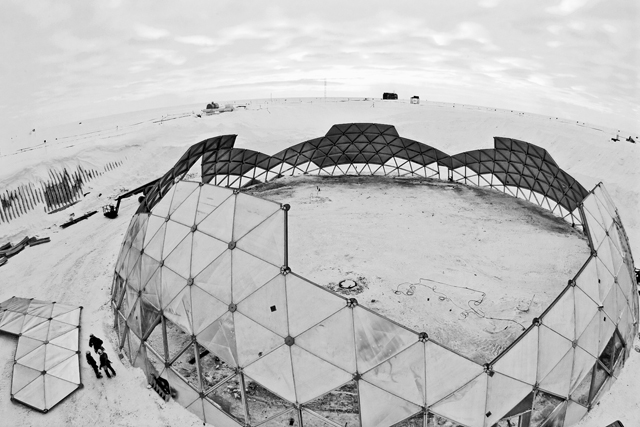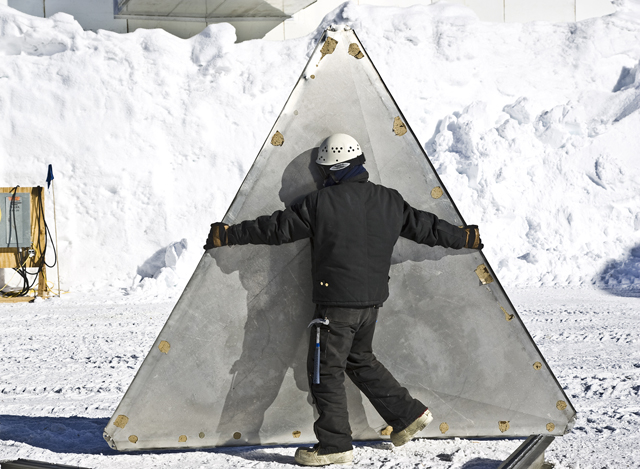The Dome is downIconic South Pole Station building disassembled and shipped off Antarctica in one seasonPosted March 19, 2010
The dome is down — marking the end of an era and completion of major modernization efforts at the U.S. Antarctic Program's South Pole Station It took a construction crew only a month to unravel the geodesic dome, which for about three decades sheltered polar researchers and support crews who lived at the bottom of the world. Deconstruction began Dec. 18, 2009 with removal of the dome crown and finished Jan. 15, 2010 with a group photo in front of the final panel. Related Information
Previous article:
Deconstruction of the Dome More pictures by Forest Banks: Dome deconstruction photos Brandon “Shaggy” Neahusan said the work was truly more deconstruction than demolition. “Originally, we planned to cut a lot of it up using abrasive saws. We found out once we got there and got on the ground, it was much easier to actually disassemble the thing than cut it up,” explained Neahusan, construction manager for Raytheon Polar Services Co. (RPSC) RPSC is the prime contractor to the National Science Foundation (NSF) “We basically ended up doing the same thing we planned to do on the crown for the disassembly,” he said, referring to the top section of the dome destined for a museum in Port Hueneme, Calif. “We just did it for the whole thing. It worked out a lot better. “It’s kind of one of things that you wouldn’t know that until you were actually in it pulling it down,” he added. “That’s the way we want a construction plan to evolve. We want it to evolve into the best practice — and it did.” Noted Leah Street, project manager for the deconstruction effort and the overall South Pole Station Modernization program: “I think the crew deserves all of the credit. “Everyone was really impressed with the crew’s attitude. Because of the nature of the dome and the feelings attached to it, the crew was respectful of those feelings as well as to the crew who originally erected it,” she said. “They were amazed at the ingenuity of that crew and wanted to acknowledge them during disassembly.” U.S. Navy Seabees originally built the dome in the early 1970s to replace the first South Pole Station, constructed in 1956-57 for the International Geophysical Year The dome, spanning 164 feet and topping out at about 52 feet high, was dedicated in January 1975. It shielded a collection of buildings that housed scientists and support personnel year-round from wind and snow. The structure far outlived its projected expiration date, allowing the NSF time to build a new a 65,000-square-foot building capable of sleeping about 150 people. The station sits on stilts capable of being jacked up twice during its lifetime to stay above the drifting snow. The new facility, dubbed the elevated station, was dedicated on Jan. 12, 2008. By that time, the buildings under the dome had been removed and the structure itself relegated to the role of a warehouse. Completion of a new logistics arch building last year for cargo and materials meant the dome was no longer needed. The cost of keeping the dome cleared of snow every year outweighed any other use, Neahusan noted. “People were sad to see it go, but they understood why,” he said. In addition, the Antarctic Treaty The original plan had called for the dome to be shipped off the continent to Port Hueneme on the 2011 re-supply vessel that visits McMurdo Station “I was completely amazed that it went that well,” Neahusan said of transporting the dome back to the United States. He credited the station’s various departments, from logistics and cargo personnel to the facilities, engineering, maintenance and construction department for wrapping the project up so quickly. He particularly singled out his team. “We had a fantastic crew. We had years of experience … They did a fantastic job.” The whole dome is off continent, Street noted, except for one panel that the crew moved into the new station. Everyone present during the deconstruction project signed the aluminum panel, inking their names into South Pole history. “People were really excited to be part of the process,” Street said. That panel is about all that’s left of the dome at the South Pole. Heavy machines have already plowed, filled and groomed snow over the crater where the building once sat for 35 years. “Probably after this season, depending on what the winds are like, you won’t ever know it was ever there,” Street said. |



For USAP Participants |
For The Public |
For Researchers and EducatorsContact UsU.S. National Science FoundationOffice of Polar Programs Geosciences Directorate 2415 Eisenhower Avenue, Suite W7100 Alexandria, VA 22314 Sign up for the NSF Office of Polar Programs newsletter and events. Feedback Form |







